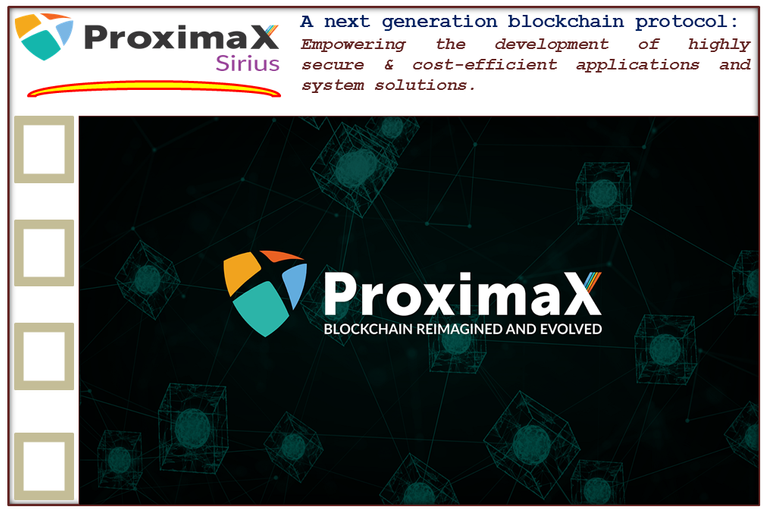

Introduction
With the inception of blockchain technology, the world realized the use-case of peer to peer transaction. But blockchain is not just limited to that. It's like a hidden treasure in the form a technology available to us. The more you dig at it, the more valuable use case you can discover that can help mankind.
The possible use-cases are many, which can not only be cost-effective for the end-users but also can be a secure & decentralized business deal. However, the implementation of this technology is not in line with its possibility. Even though the industries recognized the decentralization, the businesses are not flourishing with that pace. That is because there exists a big gap between theoretical practice and real-world applications.
There are many types of blockchain, some of them are focused on scalability, some are on storage, some others are on streaming, etc. The current state of blockchain is not being offered as a complete package bundled together at one place as a platform which can be readily offered to a business or to an individual with the fundamental benefits of blockchain technology as well as all the core services which any business in general requires for delivering its service.
It is good to offer a blockchain technology as high-performance infrastructure platform, but it is also essential to take the technology beyond that & offer a solution which can be universal to a multitude of decentralized applications. That will certainly save a lot of time & development cost. The platform should further be flexible and expandable so that the developers can add a new service unit as and when required by the business. In a nutshell, blockchain can speed up its adoption rate, if the technology can be integrated with different service units which a business requires in general. If that can happen then the best possible & ideal application and use-case can be served in a more extensive scale in the realm of blockchain platform.
This article will present ProximaX as a next-generation integrated distributed ledger technology which is bolstered by a multitude of plugins to offer itself as a complete package for various types of businesses & services. ProxiamX is powered by its blockchain known as Sirius chain.
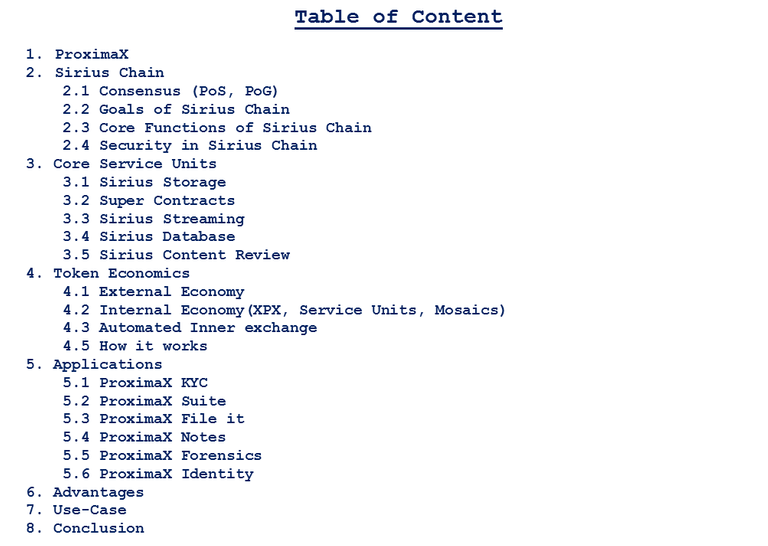

1. ProximaX
ProximaX is not just a blockchain technology or a distributed ledger technology, in fact it is beyond that. It would be appropriate to say that it is the next best version of blockchain technology which can be a universal platform that can bridge the gap between the theoretical practice and the real-world application.
Along with the parent blockchain called Sirius chain, there is a number of core service units offered by ProximaX as plugins. These plugins can be extendable and if the business requires a new plugin to be installed as per its requirement then they can do so as such. So ProximaX architecture is both expandable and flexible. The plugins can be accessible with API through SDK and HTTP endpoints.
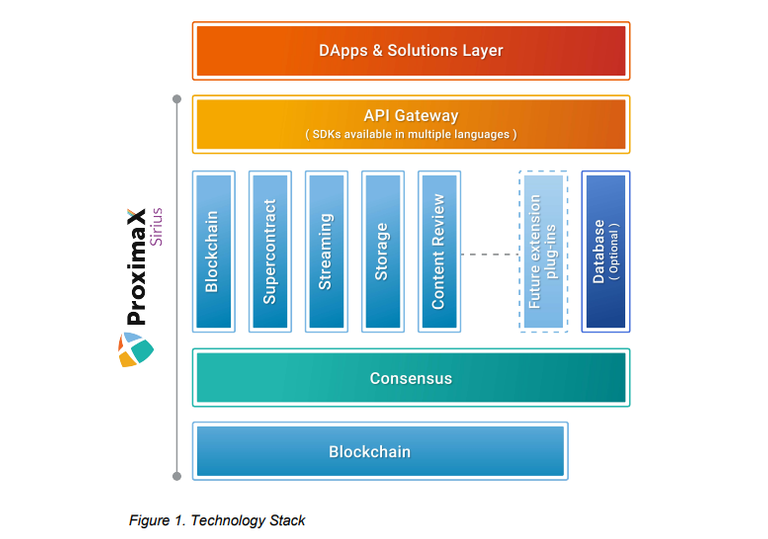
The type of available core service units is such that most of the real-world businesses can easily find these service units as useful to their businesses. However new plugins can be added to suit the business purpose. The existing service units available in ProximaX are storage, streaming, supercontracts, content review, database, etc.
The developers can build their decentralized applications on the top of Sirius chain and they can incentivize their businesses using ProxiamX platform. Any service units can be utilized as per the requirement. So the business can have the fundamental benefits of blockchain technology, yet they can leverage on the readily available core service units to benefit their business objective.
The flexibility & expandability of ProximaX platform serves a multitude of use-cases, some of them are KYC processes, business continuity, video streaming, health, identity, IoT devices and robotics, big data applications, records and reporting systems, traceability, legal and notary services, land registry, trade finance, payment and settlement, security issuance, management and exchange, workforce collaboration, messaging, and supply chain management.
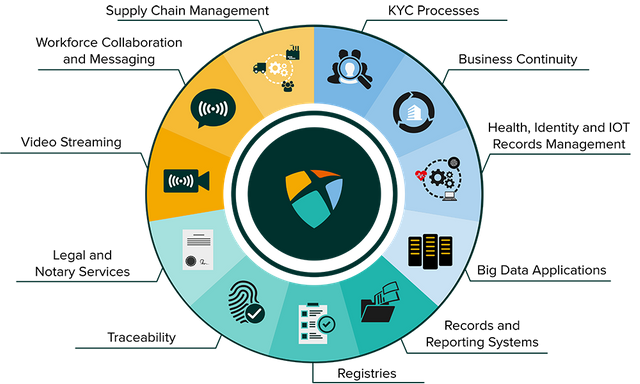

2. Sirius Chain

Sirius chain is the blockchain of ProximaX platform where all the record-keeping, validating the block by cryptographic technique happens. But Sirius chain is not a normal blockchain like other blockchains. As the ProximaX platform consists of a number of sub-components which are known as core service units in its nomenclature, Sirius chain is fundamental to these core service units. In simple words, all the core service units thrive & co-exist with Sirius chain.
With Sirius chain, contracts can be defined to serve diverse business needs and use-cases. Digital tokens can be created, asset representation can be done, etc. All the core service units are technically the digital token contracts which are defined & portrayed on the Sirius chain.
The Sirius chain uses PoS(Proof-of-Stake)+PoG(Proof-of-Greed) as consensus algorithm. PoS incorporates stake of a node and age of a node as the fundamental criteria for its selection as validator node for transaction validations. PoG ensures that a node can not be too greedy, yet accept the transaction with larger fees within the framework.

2.1 Consensus(PoS, PoG)
PoS
Sirius chain uses PoS model of consensus. Here the stake of a node and age of the node are the fundamental criteria to become a validator node. So to become a validator node, the primary requirement is to stake XPX.
Recommended minimum stake- 250,000 XPX
Recommended stake- 2,500,000 XPX
The amount of XPX staked by a node is tied to the participant's account by the validator software. If a node is successful at being selected by the PoS algorithm, then it will participate in the block generation process & it receives a share of block rewards. It generates blocks every 15 seconds. During the creation and validation of the block, the transaction fee is included.
The pre-configured default fee structure is:-
- High Transaction Fee = Recommended transaction price for consumer * 0.025
- Medium Transaction Fee = Recommended transaction price for consumer * 0.0025
- Low Transaction Fee = Recommended transaction price for consumer * 0.00025
The rental fee structure in case of Mosaics or Namespace is:-
- Mosaic Rental Fee = 10,000 XPX one-time payment
- Namespace Rental Fee = 10,000 XPX per year
PoG
Proof-of-Greed ensures an adjustable-fee network and decentralized the fee structure. With PoG a validator node can not be unreasonably greedy & can not dictate large fees for validating a transaction.
In PoG, the consumers first offer the maximum fees they can afford. All the unconfirmed transactions constitute a pool from which the validators can take up the transactions and process it & request a fee which can not be more than the maximum specified by a consumer in the pool. In simple words, lesser the fee, a validator requests, the higher possibility of recording the block by the validator. So with PoG, the fee can adjustable for both the consumers as well as the validators.

2.2 Goals of Sirius Chain
- It gurantees security, efficiency and fast processing of transactions.
- As it uses PoS which is linear and simple, it scales better when contrasted to PoW.
- The scaling capacity is achieved with minimum resource cost.
- It offers expandability and gurantees the security of the network.
- The existing core service units can be utilized as per the requirement, new service units can be added and advanced applications can be deployed.
- It can be run on a broad range of devices, including mobile phones and IoT.
- It offers a wide range of basic transaction types that launch cryptocurrencies past their core use of a payment system alone.

2.3 Core Functions of Sirius Chain
The Sirius chain has the following core in-built functions:-
(1) Account
(2) Namespaces
(3) Mosaics
(4) Metadata
(5) Multi-level multi-signatures
(6) Cross-chain transactions
(7) Aggregated Transactions
(1) Account
- An account is associated with a private key and a public key.
- Anyone having access to the private key is considered as the owner of the account and has the full control over the account.
(2) Namespaces
- Namespace is similar to the internet domain name and it is unique to the business or the assets of the corresponding decentralized applications.
- The namespace can be associated with an account address or a mosaic identifier.
(3) Mosaics
- Mosaics are the built-in contracts which are powered with unique properties such as divisibility; duration; initial supply; supply mutability; transferability.
- Mosaics are explicitly used for asset representation of decentralized applications.
- It can represent anything such as reward points, shares, bonds, warrants, signatures, status, flags, votes, or even other
currencies.

(4) Metadata
- Metadata is a data attachment to the predefined objects on the Sirius chain.
- Metadata can be added, updated and deleted.
- The predefined objects such as Accounts, Namespaces, Mosaics, etc can have additional flexibility with Metadata.
(5) Multi-level multi-signatures
- Multi-level multi-signatures helps to achieve the goal of comprehensive approval at multiple levels in business and thereby makes the execution of the workflow transparent with blockchain technology.
(6) Cross-chain transactions
- Cross-chain transactions can be done with two different chains. The two different chains can be private or public.
- Cross-chain transactions execute with an atomic swap which involves locking up of funds in the crossing chain and unlocking in the reverse.
- Cross-chain transaction facilitates a lot of use-cases and it is also essential as there are number of service units and the access to these service units requires a transaction in XPX. So the various child chains very often require the cross-chain transaction to access the various services of the mainnet platform.
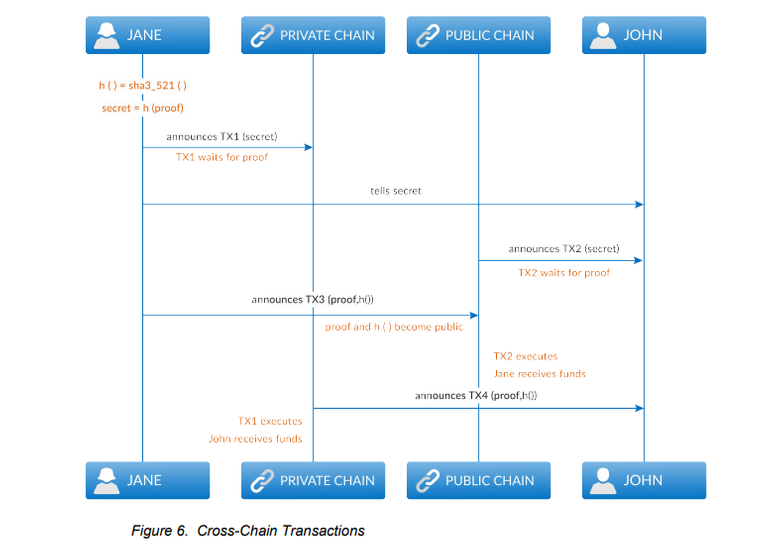
(7) Aggregated Transactions
- It consolidates the multiple transactions into one batch of transactions, which is known as Aggregated transaction.
- When all the co-signers under consideration sign the Aggregated transaction, the inner transactions are executed simultaneously.

2.4 Security in Sirius Chain
There are two major potential attacks to Sirius chain:-
(1) Zero Fee Attack
(2) Large Stake Attack
Sirius chain dealt with both the attack vectors and make them ineffective.
(1) Zero Fee Attack
PoG in Sirius chain limits the transaction fee a node can charge. The malicious validators may do the opposite and may try to validate the transaction for free an may try to gain control of the network.
In order to make this attack vector ineffective, ProximaX has set a mathematical parameter in PoG algorithm which yields higher possibility for those validators to forge a block who take an average fee.
(2) Large Stake Attack
In PoS, a node is generally selected as validator node which has higher amount of stake and if the node is relatively older. But this rule can also lead to 51% attack which is also known as large stake attack in which malicious validators may gain control of the network by becoming older and by concentrating higher amount of stakes.
In order to make this attack vector ineffective, the PoG comes into effect which gurantees reasonable spread so that even a small stake by a node gets a fair chance of being selected for validating a transaction.

3. Core Service Units


3.1 Sirius Storage
It stores all the structured and unstructured data in the form of peer to peer storage devices hosted by different nodes. Therefore it is distributed and also called as Distributed File Management System(DFMS).
The data is encrypted at the protocol level and then split into a number of chunks and then consensus is run to select the storage nodes and the data is replicated across the selected storage nodes. For storing the data the storage nodes are incentivized. It uses public-key infrastructure(PKI) and multi-signature contracts to facilitate incentivization.
The various Sirius storage actors are Acceptors, Replicators & Storage verifiers.
Acceptors are propagators of the file, Replicators store the replicated content, Storage verifiers identify the replicators. Acceptors charge SM, Replicators charge both SO & SM.
The consumers must pay fees in the form of XPX token to access and utilize Sirius storage. The XPX tokens are then converted into Service units using Automated Inner Exchange. The service units are then paid to the respective actors, for example, the Acceptors paid in SM , the Replicators are paid in SO & SM. Finally, when all the actors in the Sirius storage contracts are in agreement, the contract is then executed. The entire process is an automated process and executed at the protocol level.
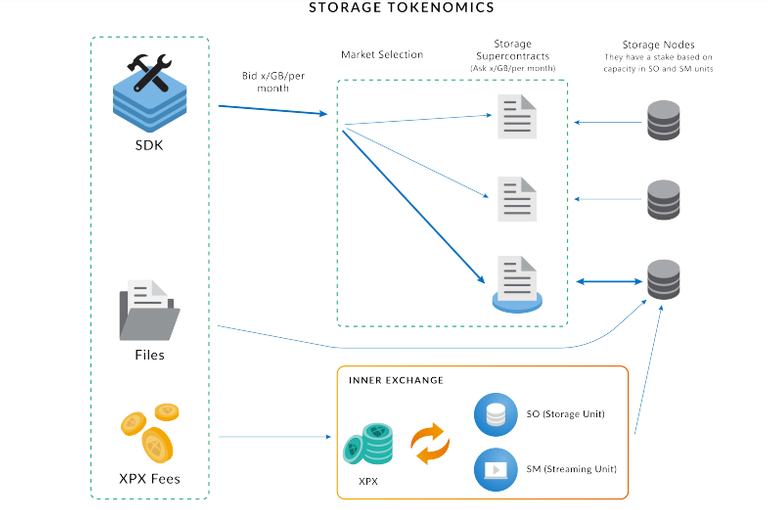
The selection of a node in Sirius storage network is governed by capacity and capability of the node owners. So a node owner pass through Proof of Storage in order to check the real capacity of the node. In proof of storage, every node is challenged by Storage verifiers and the challenge can be taken up by the Replicator by proving that it has the replication.
Sirius storage makes the Free Storage Market effective:-
- By enabling consumers to dynamically control the replications
- By making the reliability of Storage service in proportion to the amount of XPX token paid.
- By preventing node cloning.
In the Sirius storage contract the different functions that can be performed are Upload, Delete, Modify, Rename, Copy, Directory, Synchronize, etc. The communication of the message to all the Replicators which are part of the Sirius storage contract happens through gossip protocol.
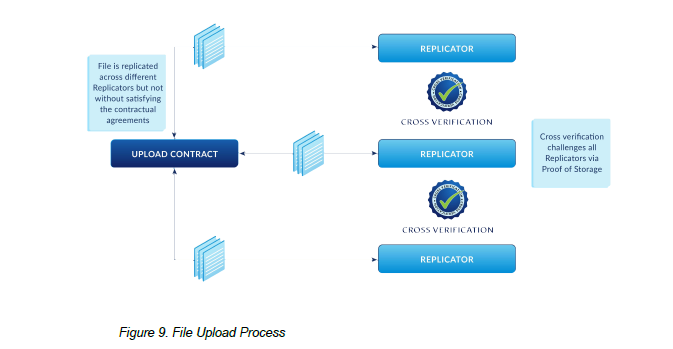

3.2 Supercontracts
It is the logic which is coded based on the digital contract obligations. The executable code is stored in the storage nodes. So the storage nodes execute the supercontracts using a virtual machine. That is why storage nodes are also known as executor nodes.
A Supercontract is different from a traditional contract of customary agreement as it very well can be modified, stopped, corrected depending upon therequirement & based on the accord from the authorized parties. In real world application, Supercontracts can be very useful when contratsed with traditional contracts. The traditional contracts once executed can not be modified, so in real world applications during unexpected circumstances the contract can not be modifed to accomplish thew business objective. In such a case the Supercontracts can best serve the venture.
In storage streaming the various actors are-
- Initiator: Creates an initial transaction for execution of the Supercontract.
- Acceptor: Delivers the information and propagates the data for Replicators and end-users
- Replicator: Replicates supercontract source code & stores the replicated code.
- Executor: Executes the code and stores the execution result.
A Supercontract can be written in programming languages like Java, C++, Python, C#, Golang, Js and Rust, etc. The complete process of Supercontract involves- Preparation, Upload, Execution, Results, etc.

3.3 Sirius Streaming
There are two types of streaming. One is "storage streaming" and the other is "live streaming".
In "storage streaming", data is pre-recorded on Sirius storage & streamed into different viewers. The data comes from the storage nodes that are in agreement to stream the data.
In storage streaming the various actors are-
- Acceptors: pre-load the files
- Replicators: replicates the files and stream it to end-users.
- Storage Verifiers: verifies the replicated data.
Streaming between the nodes happens by cryptographically signed data.
In "live streaming", the data is streamed in real-time into different viewers. Here also a set of nodes come into effect for distribution & replication of real-time streaming of data.
In live-streaming the various actors & their respective functions are-
- Stream discovery node: Keeps a list of streaming nodes.
- Stream landing node: It broadcasts to one or more Stream distributor nodes and/or Stream receivers.
- Stream verifier node: Verifies the streaming status.
- Stream distributor node: Multiplies the content and distribute to one or more receivers.
- Stream sender: Broadcasts live streaming data
- Stream receiver: Receives streaming data.

In Sirius streaming service "bandwidth" & "reputation" of a node are essential for being selected to serve a consumer.
In Live streaming protocol, the reward via blockchain is avoided as it may result in delay and real-time streaming may not be possible. In stead, the protocol uses time lags to determine the reputation based on node's bandwidth.

3.4 Sirius Database
It is a "private offering" unit & an optional service of the public platform. The application which needs a database as one of their features may utilize this core unit.
Sirius database uses Tendrmint as its consensus algorithm and it functions like document-based storage.

3.5 Sirius Content Review
This core service addresses the content managers who can make use of this core service & go for a consensus-based review in the entire network utilizing this core service unit. The censorship of the content can also be done.

4. Token Economics

The token ecosystem in ProximaX is broadly classified into two types:-
- Internal Economy
- External Economy
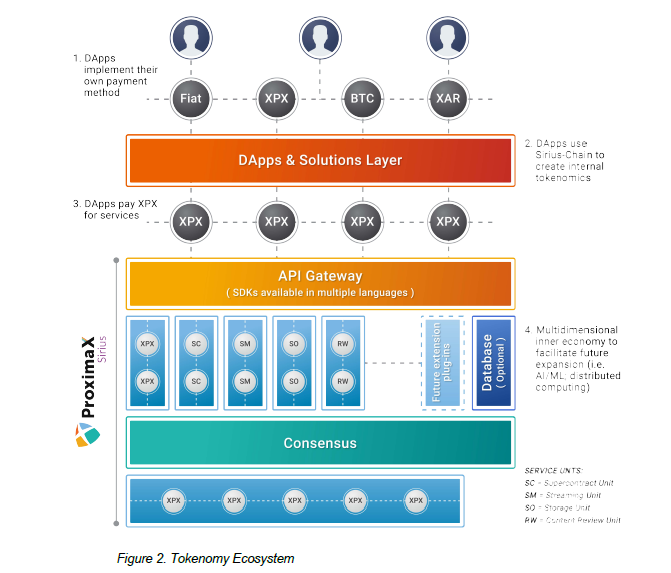

4.1 External Economy
The external economy is as per the choice of end-users. That means the decentralized applications can implement their own payment method. It can be fiat, cryptocurrency or any other payment method as set by the dApps.

4.2 Internal Economy
The internal economy of ProximaX platform mainly consists of the following tokens:-
- XPX- Which is the native token of the entire platform
- Service Units- Which are quantifiable units on the top of Sirius chain
- Mosaics- Which can be created as built-in contracts for asset representation of decentralized applications.
XPX
It is the protocol or native token of the blockchain. All the existing service units, as well as the expandable new service units of the future, are tied to XPX.
Service Units
The core service units are the quantifiable units of the platform which is used by the consumers(for accessing the platform services) and by the nodes for running & providing a service. In simple words for both consumers and the nodes to access and run a particular service, the defined service units have to be paid.
Types of Units & Initial Proposed Rates:-
- Storage Unit(SO)- 1 SO corresponds to 12 GB space per month. 1 SO= 0.004 USD.
- Streaming Unit(SM)- 1 SM corresponds to 1 GB. 1 SM= 0.02 USD
- Supercontracts(SC)- 1 SC corresponds to 1 Supercontract instruction code. 1 SC= 0.000005 USD.
- Content Review Unit(RW)- 1 RW corresponds to 1 XPX worth of paid content. 1 RW= 0.005 USD.
Apart from the defined & existing service units, the new service units can also be created as required by the decentralized application and can be used as plugins.
Mosaics
Mosaics are built-in contracts of the blockchain protocol of ProximaX which is specifically used for asset representation of decentralized applications. It can represent anything such as a currency or a physical asset or a consumption. That generally infers that it offers flexibility & adaptability for the dApps. It is also expandable, so the infrastructure tokens can be created using this tool and the designer always have a flexible hand to represent any kind of asset by using this contract.
Mosaics have the following unique properties & the customization of Mosaics can be done on the basis of these properties:-
- Divisibility
- Duration
- Initial Supply
- Supply mutability
- Transferability

4.3 Automated Inner Exchange
As Sirius chain comprises of a number of defined service units and as it is expandable, means the developers can add new core service units via decentralized applications on the top of the platform, this will give rise to a second layer economy and this inner economy is going to be vast and it may bring complexity for the users when they seek to utilize the platform's core services if there is no exchange solution available to access the second layer economy.
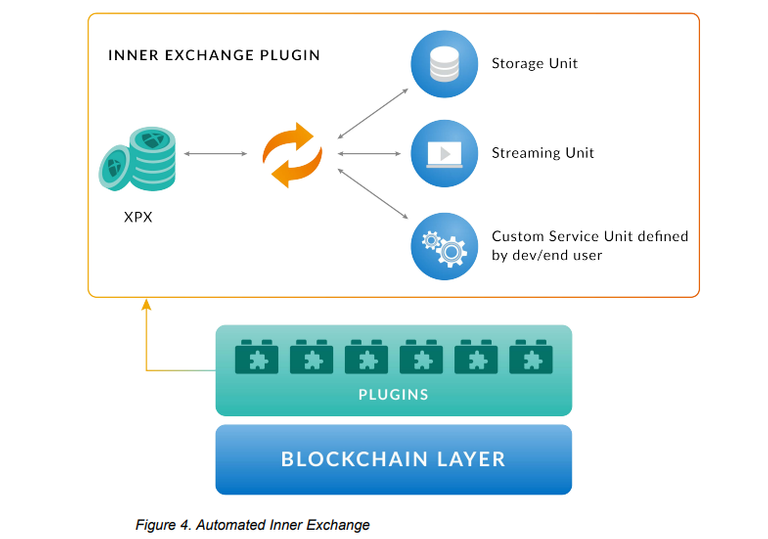
In order to mitigate this issue, ProximaX platform has developed an "Automated Inner Exchange" on the top of Sirius chain. So the different service units of the second layer economy will be able to exchange with the platform's native token XPX.

4.4 How it Works
- The dApps set their own payment method, which is a part of the external economy.
- The dApps can create Mosaics for the internal economy of their applications.
- The dApps have to pay XPX in order to utilize the Service Units.
- All the Service Units & the Mosaics can be inter-exchangeable with XPX with the facility of "Automated Inner Exchange".

5. Applications

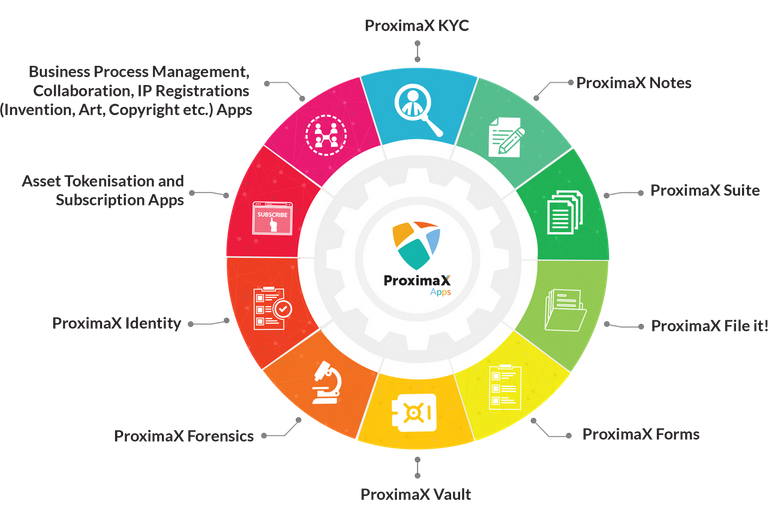
5.1 ProximaX KYC
ProximaX being distributed and decentralized offers better security and privacy for the sensitive data and it is cost-effective also as compared to centralized peers. Encryption technology ensures the integrity of the data. It also offers permission-based access to identity records. The users always have the absolute ownership of their data. As this application is offered at the service layer with SDK support, one does not have to have high tech knowledge to utilize this service.
5.2 ProximaX Suite
All the office productivity such as spreadsheets, documents, diagrams, etc can be created and shared using ProximaX suite. It prevents data theft and fraud, therefore it is better than centralized cloud based service. It uses asymmetric encryption technology and allows the file owners to decrypt their own file. It offers 5GB free online storage, for unlimited storage the user is required to upgrade to the enterprise edition.
5.3 ProximaX File It
It stores the file of the client in a distributed way across multiple nodes of Sirius network.
5.4 ProximaX Notes
Absolute privacy protection is offered as the files are encrypted. Users can embed images with the notes.
5.5 ProximaX Forensics
The investigators and scientists can leverage on this application to gather the digital evidence. It can save a lot of time and also brings efficiency in the investigation process.
5.6 ProximaX Identity
Personal information of a user can be securely verified using this application. It can also be used as a unified source of data across public and private sectors.

6. Advantages
As it offers integrated core service units on the top of Sirius chain, it can fan out to an extensive reach of business applications. It can save a lot of time and development cost.
Both permission-based and permissionless application can be built with ProximaX platform.
As it does not require high tech knowledge, it lowers the barrier to entry and the adoption rate can accelerate.
ProximaX is flexible and expandable. So it makes the developers to remain in a comfort zone as the additional service units can be added as per the business needs.
The external economy is open for the end-users, so the decentralized applications can implement their own payment method.
ProximaX has zero downtime as it is distributed.
Robust security features stand out among the competitors.
ProximaX is highly scalable; it uses a hybrid consensus of PoS+PoG to achieve speed as well as security.

7. Use-Case
Let's suppose the use-case is of Supply chain management where there is an enterprise having multiple stores at various location. If the enterprise objective is to take updates on the stores in real-time & optimize the stock availability using IoT devices, then ProximaX could be the best platform to utilize its live streaming service units.
The flow chart of the live streaming protocol for this use-case is as given below:
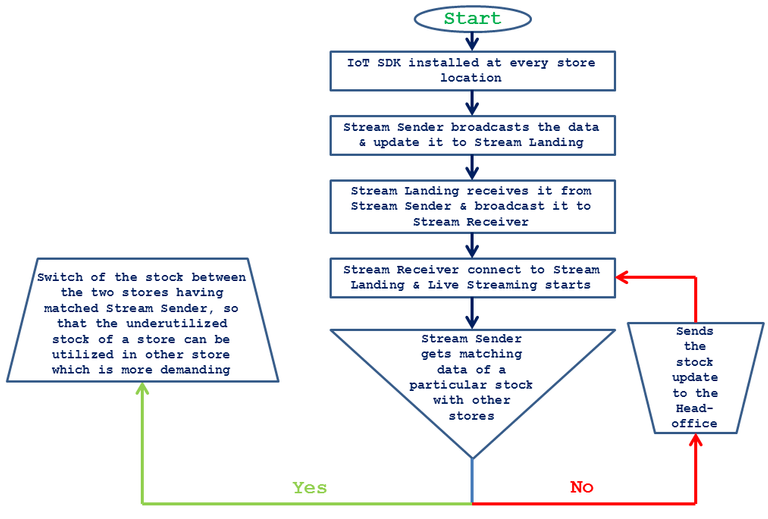
- Stream Sender: The Starting point of broadcasting live streaming of data.
- Stream Landing: The intermediate point at which the data is received from the Stream sender and broadcasted to Stream Distributor nodes and/or Stream Receiver.
- Stream Receiver: The end point of streaming data.

8. Conclusion
Offering ready-made core service units as plugins which can be accessible with API, along with the core blockchain technology is somewhat new and unique in the era of blockchain infrastructure as an offering for the business applications. The traditional blockchain infrastructure is generally offered as a raw foundation and not a complete package and at times that may lead to a lack of cohesion between the business requirement and the available infrastructure. That also comes as a burden for the developers. So that consumes both time and cost.
ProximaX has advanced its approach to offer a complete package of integrated distributed ledger technology wrapped up with core service units which are just like home delivery for the various businesses and services in real-world applications. It has all the attributes of a next-generation blockchain platform.
More Information & Resources
- ProximaX Website
- ProximaX One Pager
- ProximaX WhitePaper
- ProximaX Telegram
- ProximaX Medium
- ProximaX YouTube
Images, Logos, Screenshots
- ProximaX official website
1 !BEER Token for you
Thanks for your great informative post. Really neat structure. Looking forward to your next review.
Thanks for your contribution.
Regards,
[Realityhubs Curator]
Congratulations @groynes! You have completed the following achievement on the Steem blockchain and have been rewarded with new badge(s) :
You can view your badges on your Steem Board and compare to others on the Steem Ranking
If you no longer want to receive notifications, reply to this comment with the word
STOPDo not miss the last post from @steemitboard:
Vote for @Steemitboard as a witness to get one more award and increased upvotes!